![]()
Bob's Bulletin - Vol. 4 No. 1
A newsletter for unclassified meteorites found in the USA.
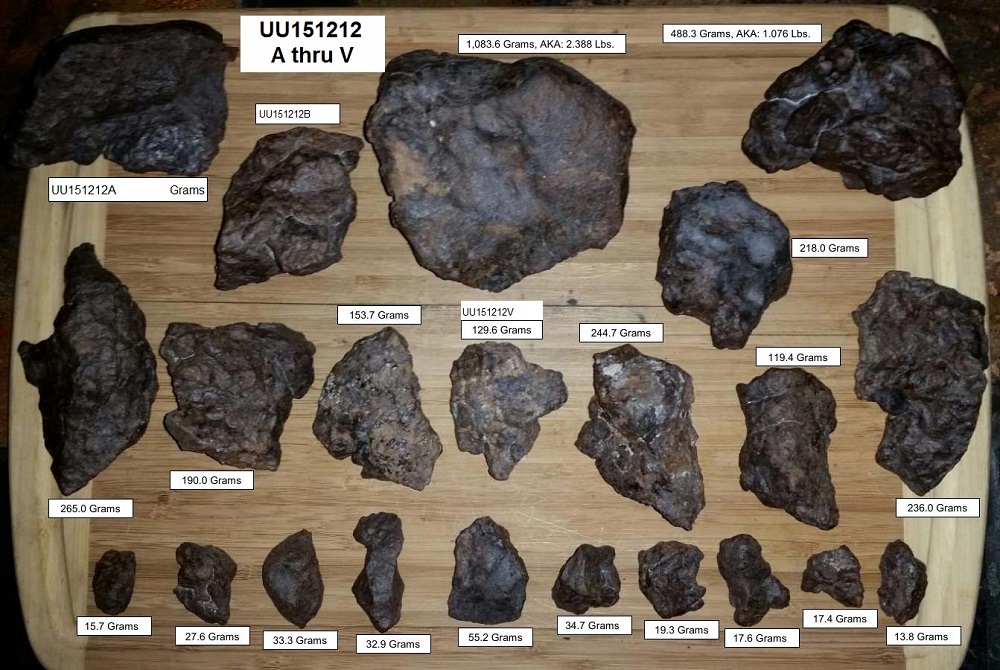
This month's edition of the "Bulletin" focuses on just some of the recent US finds that I have had the privilege to document. *** Note: Not all of the meteorites depicted in this month's article were found by me. *** For example, in the image above, all of these chondritic stones were found in a tight cluster that was being exhumed next to an eroding hummock. This cluster was found by Mark Bittmann. This image was taken by Mark. Except where noted, all of the other images in this article were taken by me. Mark found his cluster of stonys in an "officially" designated DCA (Dense Collection Area). Although finds made within a DCA can be assigned an "official provisional number" by the Meteoritical Society, for some poorly-explained and unknown reason, Mark's finds were refused provisional status.
Those meteorites that are not found within a DCA are commonly called, "cold-finds" in meteorite-recovery jargon. Those kind of finds cannot be assigned an "official provisional number" until that find is classified by an officially-approved institution. But the USA institutions are turning away finds that appear to be Ordinary Chondrites (OC). Hence, there now exists a "Catch-22" in which these "orphans" fall into, where they can't get provisionally numbered. Worse, there are no funds to record, let alone database, these orphaned meteorites even after they have been authenticated as being some kind of meteorite. Nowhere in any of this discussion is there an answer to the obvious question, "How do we really know we aren't missing something rare among all of these authenticated but Unclassified USA meteorites?" If we are so sure that they are only OC meteorites, why do we then ignore them? Now that we've removed the only good reason NOT to assign these authenticated meteorites a provisional name and/or number, why not take the next step and record them into some sort of provisional database? If the meteoriticists won't report them, then who will? Why is this a funding issue? Why is it that the U.S. is the only country that doesn't record their meteorite finds?
All of these finds depicted here were refused assignment of an "official" provisional number. For those meteorites, and other finds in similar situations, these Bulletin/Newsletters will serve as a database for these "orphaned" meteorites. An orphanage, if you will.
It is for this main reason that I will continue assigning provisional "UU" numbers for all Unclassified U.S. (UU) Ordinary Chondrite (OC) finds that I can personally authenticate.
Although my own finds would be enough to keep me perpetually busy, my point will be better made if I include other's meteorites that are in the same situation. But in order to remove any lingering doubts about the true number of orphaned meteorites, every meteorite that appears in this newsletter has to be corroborated. Unless I have personal knowledge, or, I can personally confirm the recovery data, then those finds won't appear here in this Bulletin.
So, given what you see here is a small subset, consider the meteorites depicted here to be just the tip of an iceberg of undocumented meteorites.
And therein lays the problem. There continues to be a large number of U.S. meteorites being found, and recorded by the finders, and reported to officials, but are being turned-away and forgotten. Hence, the list of these OC finds going undocumented is growing longer.
Many U.S. meteorite finds are going unreported, because of a lack of funding to classify U.S. meteorites (granted, there is funding for Antarctic meteorites), which leads to a lack of interest in OC finds by U.S. researchers. The following "Newsletter" is just one example of an alternative way in which to record U.S. OC meteorite finds. My method of assigning "Provisional Numbers", which uses the date-of-find, is "purposefully-unofficial", meaning that it actually encourages other meteorite finders (who have gone to the trouble to get their finds authenticated, but have had the door closed in their face when trying to get a provisional number, let alone a classification for their O.C.) to assign their own Prov. UU#s (which can be used as a unique Field ID number). It won't compromise my numbering sequence, or harm any other numbering system. It won't make your find any more, or less, a meteorite. The same could be said about the finds depicted in this Newsletter, but it just might get your find "through the door" of a classifier, because there is no such thing as bad-advertising. So if you think it would help to have your "U.U.O.C." depicted in a future Newsletter, just contact me.
Since this month's finds appear to be all highly-equilibrated ordinary chondrites, I will forego the "Petrographic Description" until a later time. And since nearly all of the specimens are very-weathered, I will also forego the "Macroscopic Description" until later, as well, unless more info is requested. For example, if a researcher viewing this gallery of images notices something of interest, then by all means contact this author and I will supply more details. In any case, I hope the reader will enjoy the image gallery.
Due to the on-going recovery of meteorite finds from not only these three localities, but many others, this edition of the Newsletter is going to forego (until they are "officially approved") the publishing of "Recovery Information" that usually appears here. For now, what will appear here will be a gallery of images of the finds to include their in-situ photos.
*** Note: Two of the following meteorites in this month's Newsletter were found by Mark Bittmann, and the others by this author. ***
Image of the first of eighteen (18) chondritic stones found in a tight cluster by Mark Bittmann -- hence these are all paired: UU151212A thru V
There were several more subsequent stones pulled out of this "cluster" before Bob Verish recovered his 129.6g mass.
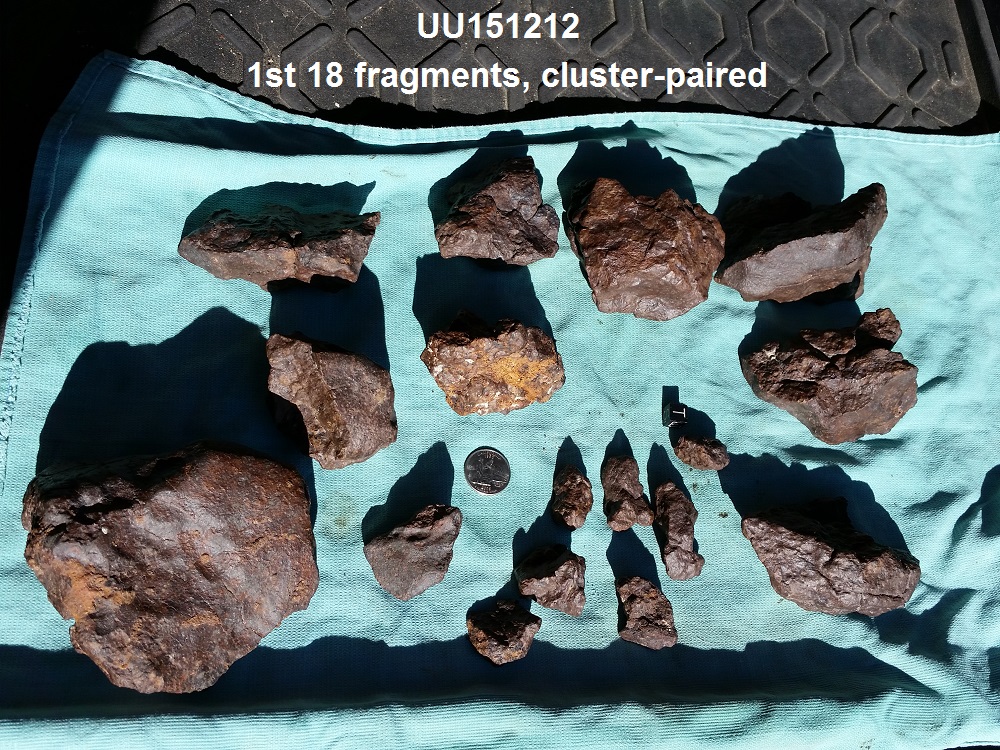
Photo courtesy of Mark Bittmann (2017).
Images of the TWO "cold find" Meteorites found by Mark Bittmann -- from two different localities:
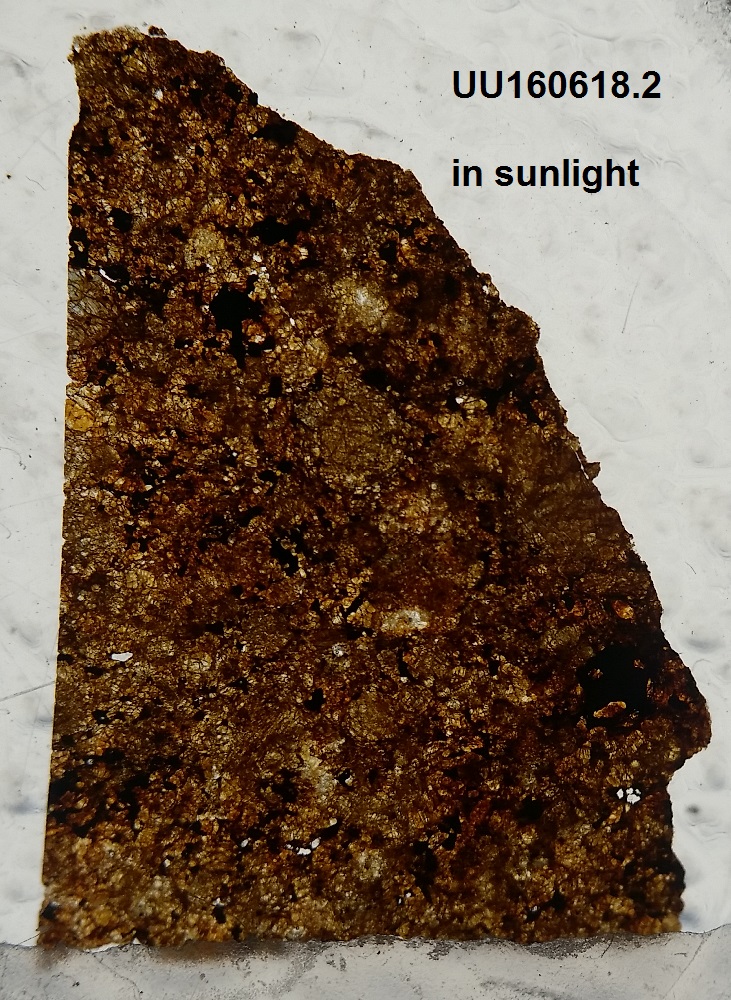
Above is the image of "UU160618" after being thin-sectioned, showing the equilibrated-chondrite interior in transmitted sunlight.
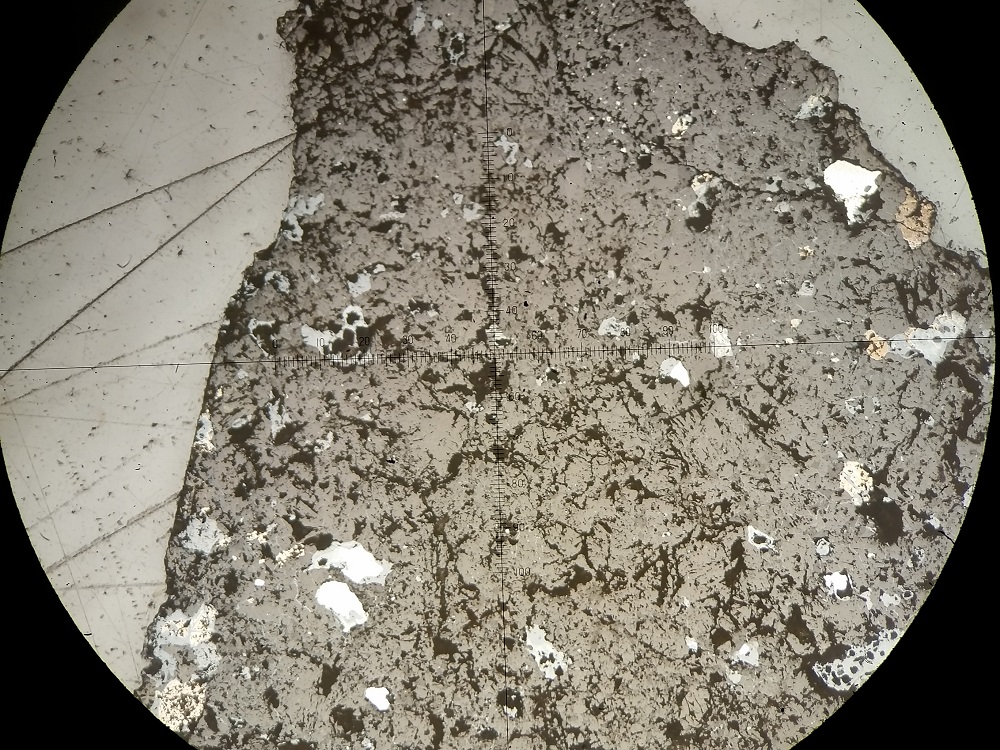
Above is the image of "UU160618" after being thin-sectioned, showing metal-grains and troilite in the oxidized interior in reflected light.
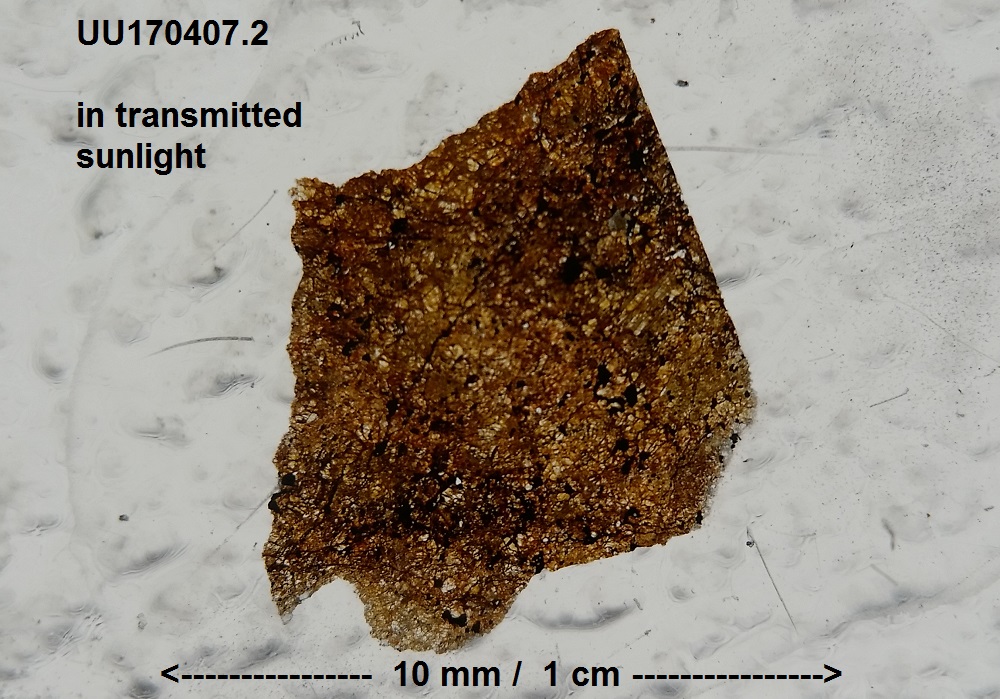
Above is the image of "UU170407" after being cut, showing the equilibrated-chondrite interior.

Above is the image of "UU170407" after being thin-sectioned, showing metal-grains and troilite in the oxidized interior in reflected light.
Images of the 4 Meteorites found by Bob Verish -- from two different localities:
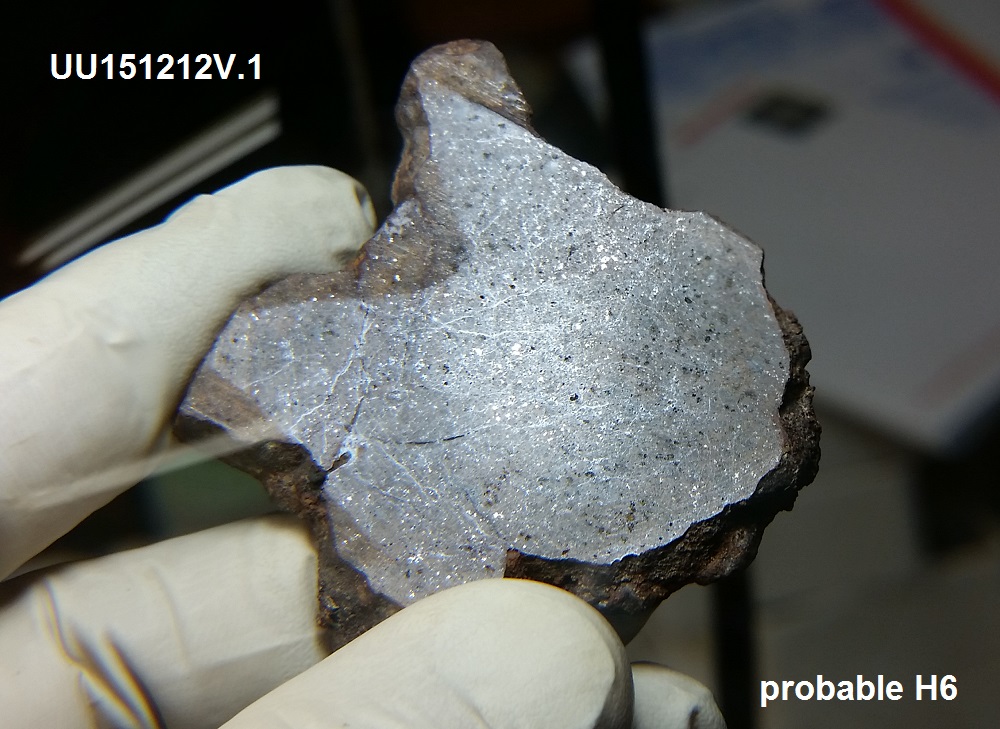
Above is an image of Bob's find from the "Bittmann Cluster" (UU151212V) after it was cut. Image courtesy Bob Verish (2016).
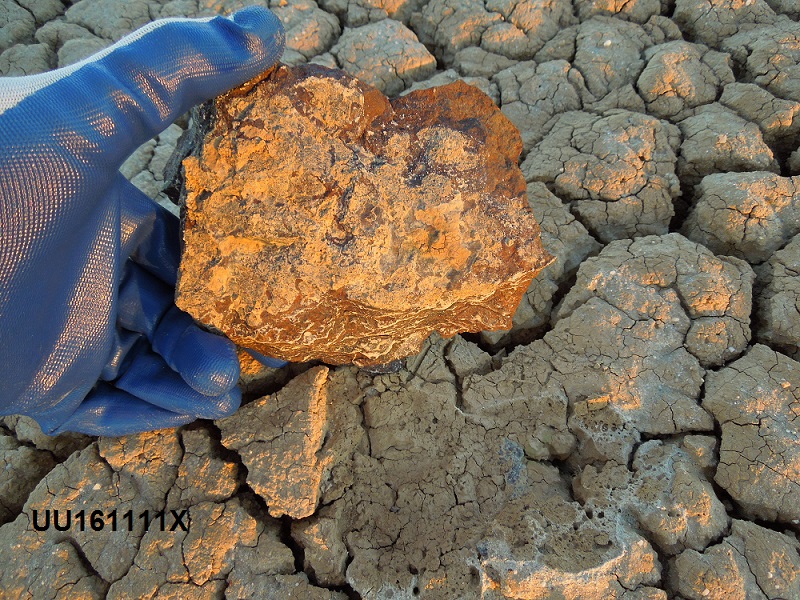
Above is the in-situ image for Bob's largest mass of the 2016-11-11 meteorite (assigned Provisional Number "UU161111X") -- Image courtesy Bob Verish (2016).
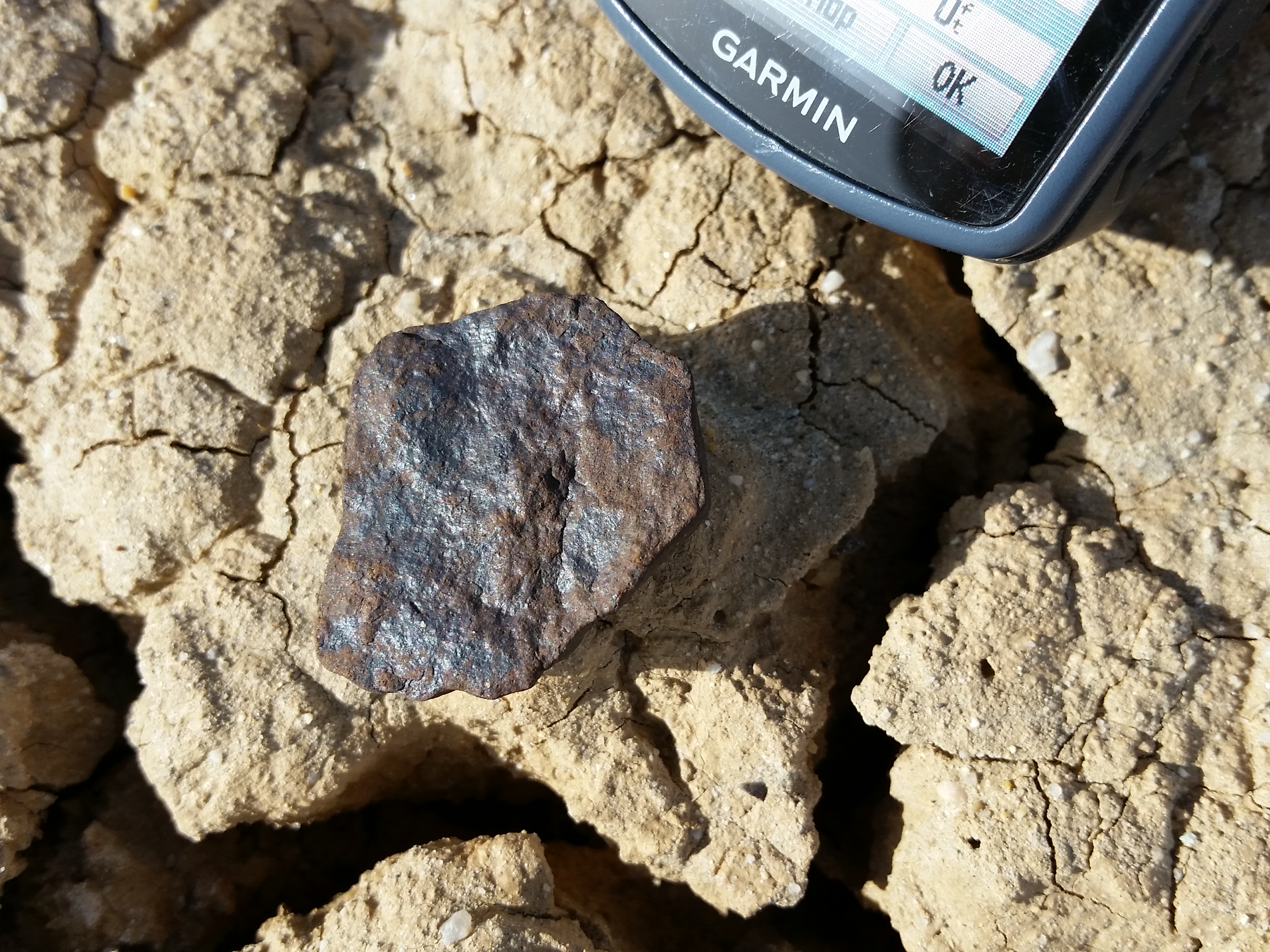
Above is an in-situ image of Bob's first unpaired find (UU161212F) from this same locality. Image courtesy Bob Verish (2016).
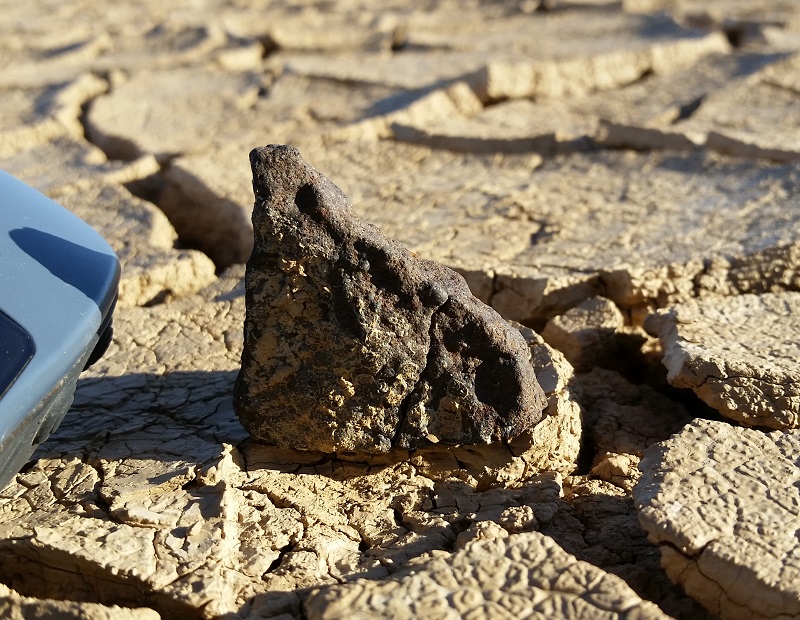
Above is the in-situ image for Bob's other unpaired find (both from this same locality) with Provisional Number "UU161213H". Image courtesy Bob Verish (2016).
Photo Gallery of the SIX-sampled & THIN-SECTIONED meteorite finds -- in this Newsletter:
The above "Newsletter" is just one example of a way in which to record U.S. Unclassified Ordinary Chondrite (UUOC) meteorite finds. Hopefully, this compilation will bring attention to the problem of the increasing number of O.C. meteorites found here in the USA, not only going unclassified, but even going unreported. Hopefully, some volunteers will offer to help establish a database that will document these "orphans".
In the meanwhile, I will do my part and continue to gather data, and along with others, make a list of what we know to be "orphaned meteorites".
Bob’s Bulletin – Vol. 3 No. 1 — In my 8th Bulletin, I published a table of sixteen (16) "Provisional (UU) Numbers" (for Unclassified U.S. meteorites) that I assigned to some finds from an existing DCA, but were refused entry into the MBD:
In all of my previous Bob's Bulletins, I prefaced each one with an explanation of what I mean by the phrase "orphaned-meteorites from the USA". I defined "orphaned" as being meteorite "finds" that are recovered in the U.S., but are not being recorded. Contrary to what you may think, these meteorites are being reported, but the finders of these meteorites have encountered resistance in getting provisional numbers assigned to their finds, even when the (obvious) meteorites were recovered from officially designated "Dense Collection Areas" (DCA). These meteorites are being ignored. This is in addition to the current practice by the official classifiers of meteorites to refuse to classify Ordinary Chondrites (OC). Without an "official" classification, meteorites cannot get an officially-approved name by the Nomenclature Committee of the Meteoritical Society, and hence, cannot be cataloged. And hence, uncatalogued meteorites are "orphaned".
Unfortunately, the vast majority of new U.S. finds are destined to remain orphans.
In my preface I would go on to explain that these "Unclassified U.S. finds" (UU) were being orphaned from the family of "approved" meteorites for the following reasons:
1) The lack of funding for U.S. researchers to authenticate, classify, and document/record these U.S. OC finds has resulted in several new [negative] trends, all which discourage finders from reporting their finds.
2) The increasing trend of commercializing the classification of meteorites by U.S. researchers has priced U.S. OC finds out of the market, and
3) The increasing trend of U.S. researchers to turn away OC finds, even when finders of U.S. OC meteorites are willing to pay for their classification.
Bob’s Bulletin – Vol. 2 No. 3 — In my 7th Bulletin, I published a table of six (6) "Provisional (UU) Numbers" (for Unclassified U.S. meteorites) that I assigned to some recent finds:
Bob’s Bulletin – Vol. 2 No. 2 — In my 6th Bulletin, I published a table of the increasing number of unclassified U.S. meteorite finds and petitioned that crowd-sourced funding be used for volunteers to compile and record these finds for later classification and official-approval, until such time that this function can be properly funded with U.S tax-dollars.
Bob’s Bulletin – Vol. 2 No. 1 — In my 5th Bulletin, I published a table of all the unclassified finds from Coyote Dry Lake DCA that were reported prior to 2007.
Bob’s Bulletin – Vol. 1 No. 4 — In my 4th Bulletin, I reported that several U.S. researchers were volunteering their time and effort to record and publish meteorite falls and finds, such as, Creston and Misfits Flat. I suggested that this method of cataloging newly found US meteorite specimens could be expanded, but the main hindrance is that there is no funding for this kind of effort.
Bob's Bulletin - Vol. 1 No. 3 -- In my 3rd Bulletin, I proposed the idea of an on-line database for these "orphaned" and other unclassified U.S. meteorites. This would have to be an all-volunteer effort, much in the same manner that the American Meteor Society has established the Fireball Reporting System. This database would give finders a central point to report their finds and have a field ID number issued to them. This "Field ID" would reflect which US state and date of find. The function of this database should not be confused with already established processes of getting a meteorite "classified", which is obviously way more labor intensive and costly.
Bob's Bulletin - Vol. 1 No. 2 -- In my 2nd Bulletin, I went into more detail about why I use the phrase "orphaned-meteorites from the USA". I focused on the lack of U.S.-tax-dollar-funding and why no funding was going towards the classification of these particular meteorites. In hindsight, I now realize that I should have pointed-out that there is also a lack of funding for just authenticating and recording that a U.S. meteorite has been found. This function should never be confused with "classifying" a meteorite, which is obviously way more labor intensive and costly.
Bob's Bulletin - Vol. 1 No. 1 -- In my first Bulletin, I introduced the phrase "orphaned-meteorites from the USA". I defined these "orphans" as being unwitnessed-fall Ordinary Chondrite (OC) meteorite "finds" that are recovered in the U.S.
Unfortunately, the vast majority of U.S. finds are of this type. I went on to write that these U.S. finds were being orphaned from the family of "approved" meteorites for the following reasons:
1) The lack of funding for U.S. researchers to authenticate, classify, and document/record these U.S. OC finds has resulted in several new [negative]; trends.
2) The increasing trend of commercializing the classifying of meteorites by U.S. researchers has priced U.S. OC finds out of the market, and
3) The increasing trend of U.S. researchers to turn away OC finds, even when finders of U.S. OC meteorites are willing to pay for their classification.
Meteoritical Bulletin: the search results for all provisional meteorites found in "USA" - Published by Meteoritical Society - Meteoritical Bulletin, Database.
Meteorites of California the list of formally-recognized California meteorite falls and finds.
My previous Bob's Bulletins can be found *HERE*
If you would like to sponsor any of these orphans, and help in the funding for getting them classified, in order to get them entered into the Meteoritical Bulletin Database, then please contact me by email:
bolidechaser at yahoo-dot-com
